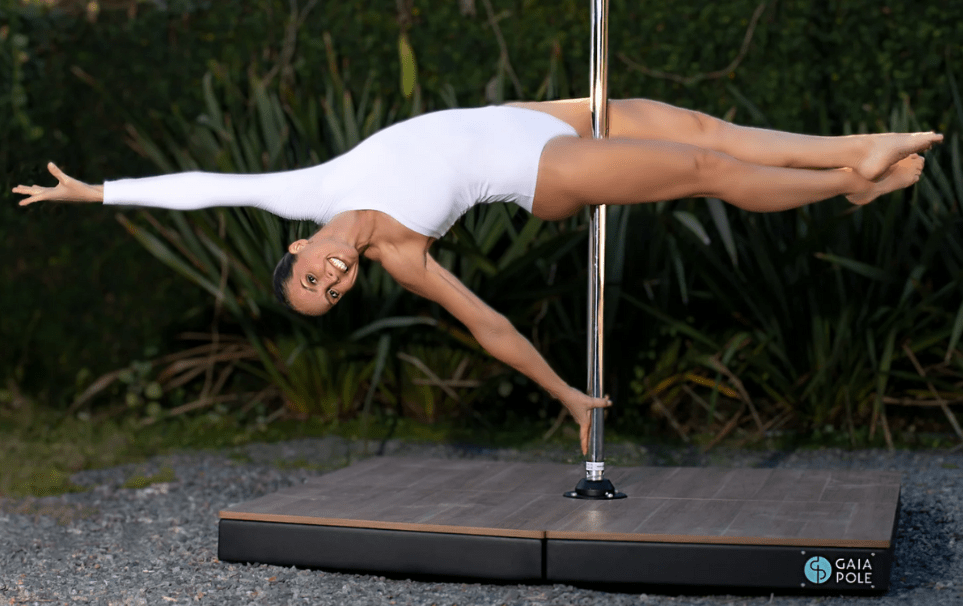Among the various movements, the tabletop in Pole Dance, also known as the “inverted Superman” or “plank,” is one of those that demands control, strength, and balance.
Usually taught during the transition between beginner and intermediate levels, this move allows easy mobility for climbing up and down the pole. Additionally, it looks great in photo sessions as a standalone pose!
The name “tabletop” comes from the final body position, which resembles the shape of a table, with aligned legs and spine. However, after mastering the move, you can incorporate spinal flexibility and start adding curvature.
Prerequisites for the Tabletop in Pole Dance
To perform the tabletop on the pole, you need proficiency in:
- Basic sit
- Understanding the “push” and “pull” mechanics
- Full bracket grip
In today’s article, we’ll explore how to execute this move correctly, along with essential tips to avoid injuries during practice.
How to Perform the Tabletop in Pole Dance?
Now that you know what the tabletop is, let’s go step by step with some essential tips to perform this move with precision!
- Starting Position: Begin with the basic extended sit position, crossing your legs. Ensure your center of gravity is well balanced.
Tip: Slightly “break” your body to the side of the leg underneath to find the lock. - Hand Placement: Your lower hand should be positioned below your body, while your upper hand stays on the pole to provide additional support before you move into position.
Tip: Use the full bracket grip with your lower hand, as it helps maintain balance and reduces the risk of injury. - Body Tilt: With a firm base, tilt your chest and head backward, away from the pole, so you achieve a plank position. Simultaneously, extend your crossed legs downward to create a counterbalance. Keeping your shoulders away from your ears will help relieve tension and reduce the risk of strain or injury.
Tip: The more you open your chest and tilt your head back, the better counterbalance you’ll achieve for the correct position. - Transition: The top hand pulls while the bottom hand pushes! Once you feel secure and comfortable in the position, you can momentarily release your top hand. This will allow you to balance using only your lower hand.
Tip: Always keep your glutes engaged and toes pointed, as this helps maintain leg muscle activation.
Exit: To exit, return the hand that is off the pole to support your movement back to the starting position. Once back, move your lower hand up, and you can finish the move by standing up with control.
Tip: When comfortable, try performing this move on a spinning pole!
How to Avoid Injuries in Pole Dance?
As with all movements in pole dance, safety is essential when performing the tabletop. Here are some tips to ensure you execute this move safely and precisely, avoiding injuries and making the most of your training.
- Warm-up: A proper warm-up before each session is crucial. It prepares your muscles and joints for the effort, helping prevent future injuries.
- Respect your limits: Progress gradually in your movements, respecting your body’s limits to avoid overloading. If you feel uncertain about a move, give yourself time and try again later.
- Body awareness: Maintain control of the movement at all times. Your grip should be firm, and your muscles engaged to ensure stability. Always focus on keeping the right muscles activated.
- Supervision: Whenever possible, train under the supervision of a qualified instructor who can correct your posture and technique, minimizing the risk of accidents and injuries.
- Stretching: Don’t underestimate the importance of stretching after training. Equally as important as warming up, stretching relaxes the muscles and helps prevent soreness.
With regular practice and attention to safety, the tabletop can be an excellent addition to your pole dance repertoire.
Want to know more about this amazing practice we love so much?
Check out our other articles on the benefits of pole dance for the body and how this activity can transform your physical and mental health.
